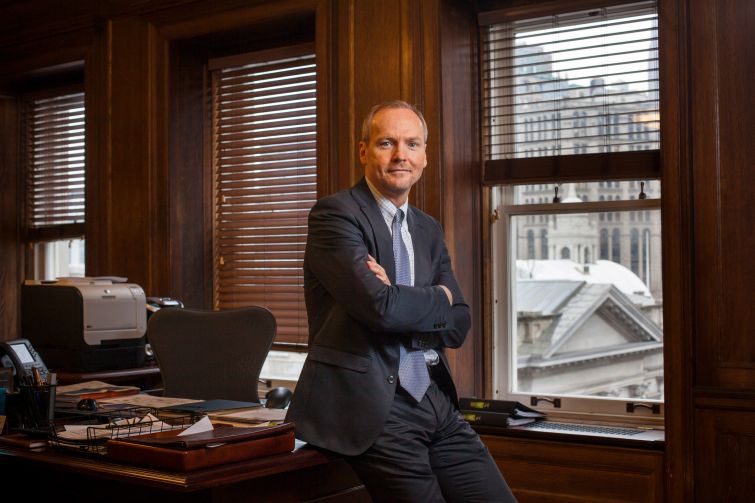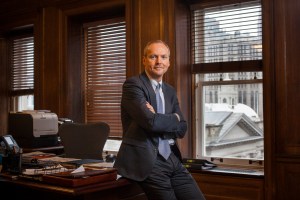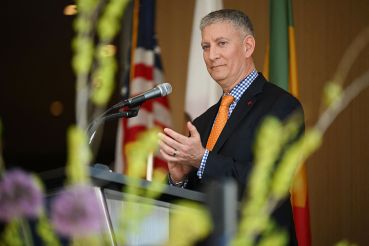Commissioner Rick Chandler on His Second Stint With the Department of Buildings
By Danielle Schlanger February 4, 2015 11:00 am
reprints

Most of New York City’s 8.4 million residents are able to sleep at night rest assured their roofs will not collapse and their children’s school will not crumble thanks to the New York City Department of Buildings. Commissioner Rick D. Chandler is responsible for the day-to-day operations of this organization, ensuring that the five borough’s 975,000 buildings and properties are safe and secure. Mr. Chandler, a professional engineer, was appointed by Mayor Bill de Blasio last July; since assuming the position the following month, he has collaborated with other government agencies to advance the mayor’s agenda on universal preschool and affordable housing while simultaneously propelling his own department forward by streamlining and utilizing technology. Actually, Mr. Chandler was no stranger to the DOB; he had served as a borough commissioner of Queens, Brooklyn, and the Bronx for the department from 1995 to 2002. Most recently, he had been the assistant vice president of facilities at Hunter College.
Mr. Chandler sat down with Commercial Observer to discuss his vision for the DOB, the use of technology in filing applications and the safety of construction sites.
Commercial Observer: You worked at the Department of Buildings before you went to Hunter College. How is the department different than before?
Mr. Chandler: It changed tremendously, and part of the reason I’m thrilled to be back is because the place has changed for the better. We have a tremendous talent pool to respond to emergencies, to evaluate structures, to ensure safety at a level that was not conceived when I was here before. And the organizational structure is such that our zoning and code talent can focus on the development side. We can have an ongoing team of people who are constantly evaluating the codes and keeping us current. Those are some of the changes that occurred while I was away. There’s just a lot of opportunities to improve. And that’s why I’m excited.
What do you hope to accomplish during your tenure?
There’s a great foundation that’s been laid in the last few years. The department has really made some excellent strides in its division of development and enforcement and has added quite a few tools, and I think that there’s just some momentum to move the agency further in its technological acumen and its ability to serve the public. I think we have great staff on the safety side and the development side; my goals are to advance that even further. Right now, we’re doing an assessment and we think we’re going to have a plan to move it forward, to achieve the mayor’s goals and also continue the processing of thousands of applications that come through on a daily basis.
We want shorter times to process applications. We want shorter times to get inspections performed. We want shorter turnaround times to process applications for permits and ultimately, for certificates of occupancy. The goal is to shorten those time frames.
In October 2011, former Commissioner Robert LiMandri created the NYC Development Hub for filing construction plans. The plan review center was created to accelerate the construction project approval process, but we have heard complaints that the system is slow.
[The NYC Development Hub] is definitely something that we’re committed to. We think it’s a great idea and it’s been in place for three-plus years, and we’ve identified the inefficiencies. We’ve listened to people and their complaints. We’ve listened to the developers and the people that use the system. Our goal is to improve our ability to accept online payments. The hub allows you to file a drawing online, but some of the inefficiencies are related to online payments and filing amendments to the original application because most jobs involve amendments to the original application. You should know that we receive as many compliments as we do complaints, and we’re very enthused by the positive feedback we receive.What do you think your predecessor [Mr. LiMandri] did well?
I think he used resources that were given to him. He was provided significant resources, and so he used them.
Are you provided the same resources?
We’re working on it. We’re consistent with the budget from last year. So, we have room to grow obviously and I’m prepared to lay a plan out to do that. But one of the things that was done in prior years was fairly efficient use of resources to add staff, add talent and implement technology where it hadn’t been before.
Many people declined to take this job; [it was the last major vacancy filled by the mayor]. Why did you decide to accept it?
I started my career here and I really do have a passion for what this agency does. I strongly believe in what we do in terms of reviewing for compliance in the city. It’s a fascinating field to look at zoning and code issues and the development issues of New York.
What do you think the hardest thing will be to tackle during your tenure?
It’s a number of things. Any time you approach the development community and our internal culture [at DOB] to shorten time-frames [for expediting projects] that is always a challenge. Every commissioner prior to me has sought to shorten time-frames and ease the permitting and sign-off process. So yes, that is going to be one of the largest challenges.
Another one is to to achieve the mayor’s affordable housing plan and assist the “Small Business First” initiatives. These are real challenges, to bring multiple agencies together to assist in completing the infrastructure requirements to get these programs going. That would also involve the mayor’s vision for UPK [universal preschool]. We were very involved in that, and that was quite a challenge that we were successful in.
In terms of securing space?
Correct. We partnered with the Department of Education, FDNY, the Department of Investigation and others to ensure that the space was there. 2015 is going to see an expansion of the UPK enrollment, and we will play a major supporting role in securing those spaces. So that, too, is a challenge. I think I’ve highlighted, like, four or five things.
I think what becomes somewhat obvious is there’s an awful lot of issues at one time, so the challenge for this position is to keep moving forward on all of them at the same time.
It’s easy for any leader in any agency to say, “O.K., just quadruple my staff, I can do all of those things.” But I don’t think that’s leadership. I think that’s the easy way out.
For many years, the safety of cranes was one of the most high-profile construction issues in the city. Do you think that cranes are more secure now than they were five or 10 years ago?
Absolutely, without question. In fact, it’s one of the first things that I did when I came into this office was sit down with our assistant commissioner over safety operations and talk to our crane people because honestly, I’m not a crane expert and I wanted to see what we do to monitor them.
“High-risk construction” is how it’s known in the industry, when you erect tower cranes. It’s complex to erect a very, very heavy structure that towers that high above the ground and is connected to the building that you’re building. And then you have to raise it as the building raises. So we have a very dedicated and sophisticated crane team that tracks every crane. We know every crane that’s in the five boroughs and we know where they are.
How many cranes are there up right now?
As of today, there are 30 active tower cranes across the city.
Data shows that accidents, injuries and fatalities rose for the first nine months of 2014 compared with the same period a year prior. To what do you attribute this?
We think it’s attributable to the significant increase in the number of permits being issued. We’re up about 14 percent in permits in 2014 compared to 2013. I think [the increase is] because of the economic reasons. I think it has a lot to do with market forces.
How do you plan to address this uptick?
We continue to campaign for safe construction projects. We have seminars and educational events. For example, earlier today, I was working with the communications department working on promotional materials for a conference [called the Build Safe/Live Safe Conference]. It’s a one-day conference and we fill it to capacity. Our safety experts provide presentations about safe construction and chapter 33 of our code, which is the code that addresses construction safety. We have a Building Enforcement Safety Team and those inspectors make regular visits to job sites that have site safety managers. They also respond to complaints about any site around the city. We also have an entire unit devoted to reviewing demolition and site safety plans. They are constantly reviewing applications to ensure that site safety is maintained on the larger sites. So that’s what we’re doing about it.


